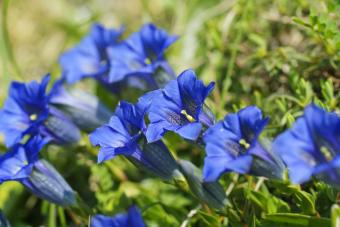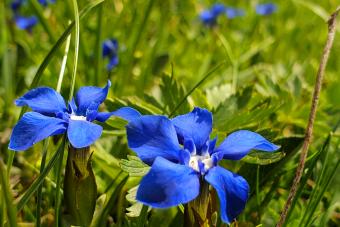
Beautiful, delicate, picky as all get-out, gentians are a challenge for many gardeners. That said, if you can give these notoriously picky plants the conditions they prefer, you'll be rewarded year after year with absolutely stunning blooms.
Growing Gentian in Your Garden
Gentian is one of those plants that should really get more love from gardeners, but the fact is that despite being beautiful, it's a little... temperamental. It's picky. And it's not easy to propagate. It doesn't like to get too hot, and it wilts if it's exposed to too much sun.

Yes, gentian is a diva of a plant.
But if you can give it the right conditions, gentian will reward you with bright, vibrant blue flowers and delicate foliage for years to come. Plus, there's that little bit of gardener's pride in knowing that you can grow something that many gardeners find challenging.
Gentians are hardy in Zones 3 through 7, but they'll be happier in those climates that have long, cool springs and falls and short, not-too-hot summers. They prefer shade, ideally with a bit of morning sun. And they need moist, fertile, well-drained soil to thrive.
If you can give gentians all of that, they'll reward you by not only surviving, gifting you with stunning, bright-blue blossoms every year, but also by spreading, forming a creeping, lush carpet of gentian plants.
Depending on variety, gentians grow from four to 12 inches tall and have wide, star-shaped blooms with a trumpet-like form.
How and When to Plant Gentian
Gentian plants are very difficult to start from seed, with erratic germination and a low rate of germination in general. It's much better to start from transplants either in spring or fall.
They aren't very common plants, so if your local nursery doesn't carry them, your best bet is to find online plant retailers. Those that specialize in North American native plants might be a good place to start.
Types of Gentian Plants
While there are over 1,000 varieties of gentians in the wild, only a handful are commonly grown in home gardens. These are generally varieties that have the prettiest, most reliable flowers and that spread, self-propagating if they're given the right conditions.
Spring Gentian
Spring gentian (Gentiana verna) is one of the most beautiful of alpine flowers, with tiny, deep blue, star-shaped flowers that bloom in late April through early June in most areas. Because it's so small, this plant is best planted en masse, in sweeping drifts so you can fully appreciate it against a backdrop of larger plants. It grows to about six inches tall and spreads under the right conditions. However, it absolutely loathes heat, so if you live in an area warmer than Zone 6, you might have a hard time growing it.

Bottle Gentian
Bottle gentian (Gentian andrewsii) reaches two feet tall and blooms in late summer to early fall. Its name is due to the unique forms of the blue blossoms, which never fully open, always resembling bottles. They're slow-growing, but maintenance free once established.

Willow Gentian
Willow Gentian (Gentiana asclepiadea) grows up to two feet tall and produces good-sized flowers of a purple-blue along nearly the whole stem in late summer and autumn. This Gentian will grow in open woods and is good for naturalizing in mixed borders or the edges of woodland gardens.

Chinese Gentian
Gentiana Sino-Ornata is an autumn-flowering species of gentian with rich blue blossoms. Of all the different gentian varieties, this one is probably the least fussy, more able to withstand heat than the other varieties available. It's also easy to propagate via stem cuttings.

Bavarian Gentian
Bavarian Gentian (Gentiana bavarica) is similar in appearance to spring gentian, except that it absolutely thrives in boggy spots. So if you have a spot in your garden that gets partial sun and tends to stay on the wet side, that might be a good spot to try growing Bavarian gentian.

What to Plant With Gentian
While the best way to grow gentian is usually in large drifts, they can also be paired well with a few other garden plants to highlight the beauty of their blooms and foliage, and to ensure that something is always blooming even when the gentians aren't. Consider planting gentian with:
Gentian Root: Herbal Uses for Gentian
Aside from its use as a landscape plant, there are also traditional, medicinal uses of gentian. The most commonly-used part of the gentian plant is its root, which is typically brewed in teas, or infused into bitters or liqueurs. It's traditionally been used to treat inflammation and swelling, though it can cause gastrointestinal issues.
Tiny Showstoppers
If you love blue, and you can find the right conditions in your garden, gentians are definitely worth growing. In the end, patience and being willing to accept a bit of trial-and-error are likely the keys to success in growing these notoriously picky but oh-so-stunning little plants.







